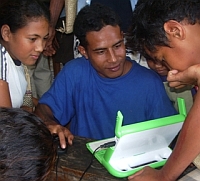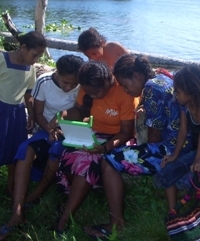Congratulations OLPC Oceania! What was once just a South Pacific publicity tour with BTest-2 "$100 laptops" has now grown into a full-fledged pilot deployment of 20 XO computers to test constructionist learning on the Solomon Islands.
OLPC Oceania, with Pipol Fastaem, hopes that Children's Machines will improve education, literacy and life long learning of students beyond current satellite receiving stations, and if pilot testing of One Laptop Per Child is successful, they would expand one-to-one computing across the Solomon Island education system.
But unlike Nicholas Negroponte's grand hope for a "Big Bang" rollout - all computers to all children all at once - OLPC Oceania's locally-designed distribution model is taking a much more logical, pragmatic, and measured approach according to ComputerWorld:
A second more ambitious project aims to deploy 100,000 of the laptops throughout a number of the Pacific islands. However, this would be done gradually, by equipping one village at a time. Here the aim would be to cater to the needs of children who can’t get to a school.Kudos to OLPC Oceania for their localized, "learning by doing" model of OLPC implementation. May both the initial pilot and the greater Solomon Islands rollout meet with great success across all 1,000 islands!Twenty to 50 PCs would be provided per village under OLPC Oceania’s plan. These would be linked to a village server, which would be linked, via a "thin" satellite or wireless link, to an internet access point, says Ian Thomson. Most of the content would be kept on the server, to minimise the need for longer-distance communication.




For more information, at least on the Solomon Islands part of this initiative, this is linked to the Distance Learning Centres Project http://www.schoolnet.net.sb an EU-funded rural project run my the Ministry of Education. Through this linkage, curriculum integration is included in the plan.
However, as the PFnet/DLCP stations are strongly community-based, any OLPC roll out will be strongly village-focused, using the same tried and tested participatory methods in the implementation. Thanks to Wayan for posting this.
David, how was the installation powered? Gasoline or diesel generator? Or was there some other source? Solar or wind? How much power was necessary to run everything?
What about hardware issues? Breakdowns and damage? Spare parts and repair instructions?
Was the school server run 24/7? How about the internet link? 24/7?
How much localization was done, necessary?
How much in the way of local resources, i.e. educational materials on the school server, was there? Any? Enough? What would you change?
Where does your feedback on the project show up? Is it publicly accessible?
David,
You're welcome. I love the locally managed aspect of the OLPC Oceania testing and rollout. As you get results from your tests and hopefully expand along the Solomons, please keep us informed.
I hate to disappoint people, but actually this posting is based on media reports that are a little premature, following our regional Pacific Internet Society meeting in which our "OLPC Oceania" working group gave a panel presentation and demonstration of the 20 B2s that we have been given by OLPC. The pilot is not yet underway.
However, I can share our hopes and strategies. We will post articles on this site as we progress.
Firstly, the OLPC Oceania group is developing a regional plan linked to the Pacific Islands Forum's Digital and Youth Strategies, with the Secretariat of the Pacific Community (SPC) taking a lead role. We're not the only group working on OLPC in the region - we hope we can combine our various strengths and experiences.
It's important to understand that the region is made up of small countries, many with populations less than half a million, yet with their populations scattered across a huge area of ocean. There is very little infrastructure in the rural areas. Each country may have a telecommunications monopoly that restricts innovation with modern ICT technology. Internet costs and quality of service - in comparative terms - would shock most of you readers. To tackle these common problems, the Forum brings member countries together to share resources, technical assistance, policy development and to leverage the combined aspirations of the members.
Against this background, a number of ICT4D interventions have attempted to find sustainable solutions to develop rural access and capacities. This is happening in tandem with national ICT strategy / "enabling environment" initiatives.
In the Solomons PFnet was started as a community networking service to reach (some of) the 85% of people living in rural areas. After set-up, it's an ultra low cost model – using HF radio email and solar power. All the "email stations" are community-managed and the network grows as new groups mobilize and come forward to request stations. It really is a bottom-up approach, and the more I work in this area the more I appreciate the first principle that everything depends on a strong pillar of community support and active participation.
The Distance Learning Centres Project (DLCP) then followed on with EU funding, run by the Ministry of Education, building that basic community-based access to improve educational services in rural areas. VSAT and better human resource capacities were brought in. It's in this context that I came into the OLPC, looking for a way to expand the DLCP model to reach out further into the communities and remote areas, with linkages to a full spectrum of educational services - literacy, livelihoods, academic, technical, teacher professional development.
The new range of purpose built low cost laptops are also low power and low maintenance - and the support required is reduced further if you have saturation, as teachers and other village people will become natural trainers and techies. There are many variants but the OLPC stands above most of them for many reasons, not least the sharing and mesh networking capabilities.
Anyway, to answer your questions. We have contemplated a pilot in Marovo Lagoon, where a number of factors have come together to make it very attractive, as I’ll try to explain.
We first need to develop an implementation plan/model that will work and be scalable, and provide lessons for the region in developing their own country plans. How to distribute the laptops is an interesting problem in itself. We have to avoid creating disputes and a free hand out mentality that does not value their new asset. We believe we can only make that a success through a participatory development approach where the communities design the process themselves, and through involvement of as many potential service providers as possible (information, education, aid programmes, government, media, etc). Our PFnet and DLCP sustainability strategy hinges on making the ICT as useful as possible, cutting across all sectors. So the pilot has also to obtain the buy in of all these providers. After all, the laptops are likely to become a front line – first mile – in the country’s rural communications infrastructure, and we can’t afford a poorly planned implementation that leaves them sidelined. Crucially, we don’t only have one country’s government and their development partners to convince, but a whole region. To justify and obtain appropriate funding that will allow the region access to the OLPC programme and a full scale roll out, we have to show that it can work.
A key tactic in the pilot is to link the distribution of the small batch of laptops that we have (20) to existing educational programmes in Marovo Lagoon. These include a biodiversity project run by University of Queensland, and a conservation programme run by Conservation International and others, to create viable alternatives to logging for rural communities. These programmes can be delivered, monitored and managed through the laptops and supporting infrastructure – a small community tele-centre based in a rural training centre in the village, linked via a 23km wireless bridge to a VSAT site (a DLCP distance learning centre). The server will be based there. The operator is already selected by the community and is has the capacity to develop content via blogs, CMS websites and other simple stuff. The other key partner – as the pilot is largely funded by the Ministry of Education through the EU sector programme – is the Curriculum Development Centre. They need to learn about ebooks, elearning resources and how to start using computers in the classroom. Thus, one might imagine some simple first steps in testing curriculum-related content via the OLPCs.
It’s all about partnerships, dynamics and resulting synergy. This is the approach we’ve followed all along with PFnet and DLCP.
Current status is that we have built the strong, solid community awareness and very active support, sealed with an agreement signed by landowners, elders, the RTC, school and church representatives. This had made the deployment of our wireless link a relatively simple matter limited to the technicalities. It’s amazing what one can do when you have mobilized all the community. The computer centre where the server will be placed is to be completed soon after, but the OLPC pilot needs some work – we have to complete the design and ensure the participation as described above. It’s likely to take place later this year, we hope, when all parties including the Ministry have agreed on the plan. At that stage we’d be happy to share our experience on this forum.
We also haven’t decided yet on the power issue, but it’s likely to be a mix of small distributed solar charging facilities and a central gang charger backed up by the village generator when it has fuel and is running. It’s interesting when one gets down to the practicalities, how many assumptions are revealed to be inaccurate. For instance, villages here are more than likely to be made up of many small hamlets strung out along a shoreline with headlands, trees and other features preventing the propagation of the mesh network. Children often paddle to school from these hamlets. How to provide wireless access to all of them will also be a challenge. We are working on it.
Internet security and risk is also an issue we will tackle with a mixed approach. For the pilot we provide Internet access via the DLCP VSAT network and are thus able to filter traffic at the hub (we use a Content Keeper appliance). However, it’s also necessary to raise awareness that the community also has to manage this risk themselves, in the same way as we all do where access is taken for granted. We can educate and provide simple methods to families on how to safeguard their children. This will as always be engineered via the community structures (committees) involved in the implementation.
Finally, we need a set of clear objectives with measurable indicators, and research questions that are posed and answered by the pilot.
David Leeming,
"We believe we can only make that a success through a participatory development approach where the communities design the process themselves, and through involvement of as many potential service providers as possible (information, education, aid programmes, government, media, etc). Our PFnet and DLCP sustainability strategy hinges on making the ICT as useful as possible, cutting across all sectors. So the pilot has also to obtain the buy in of all these providers."
David's detailed description of their project illustrates why calls for olpc to develop a uniform, "one-size-fits-all" implimentation strategy is a mistake. There is so much variation among target areas, and so many different implimentation possiblities, that it makes much more sense for each region to develop its own, custom-designed implimentation strategy.
Do you still plan to sell this to the public in the future? If so, when?